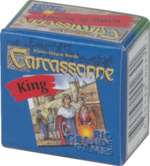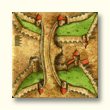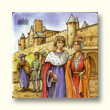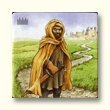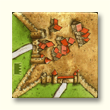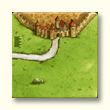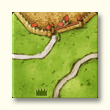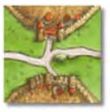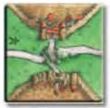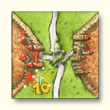Translations:Count, King and Robber (1st edition)/10/en
King and Robber Baron
<translate> </translate>
<translate>
 |
You are reading the rules for this tile design. |
 | Read the following rules if your tiles look like this. |
| If your tiles have a different design, then choose a game from Spin-offs. |  |
General info and comments
King and Robber Baron was originally released by Hans im Glück in 2003 (as part of King and Scout, which also featured 5 tiles for Hunters and Gatherers).
In 2007 it was released as part of ![]() Count, King & Robber.
Count, King & Robber.
Contents
- 5 new land tiles
- 1 King tile
- 1 Robber Baron tile
Rules
Preparation
The 5 new land tiles should be mixed with the rest of the tiles. This expansion has been developed for the Carcassonne basic game and can be used with any or all of the other expansions.
The King and The Robber Baron tiles should be set aside at the side of the playing area, as they will be used later.
Placing a tile
When you draw one of the King or Robber land tiles, place it according to the normal rules.
During the course of play they may nevertheless become connected, and then count as only one segment.
Deploying a follower
When you place one of the King and Robber land tiles, you may place a meeple on it according to the normal rules.
Scoring
When you complete one or more features (e.g. a monastery, a road etc.) by placing a King and Robber land tile, it is scored according to the normal rules.
A completed city
As soon as a player completes the first city (in the game), he or she should take the King tile.
If, during the course of play, another player completes a larger city [1] — which means he or she places the final tile of this city — then he or she receives the King. [2]
A completed road
The Robber Baron functions in the same way as the King.
As soon as a player completes the first road, he or she should take the Robber Baron tile. If, during the course of play, another player completes a longer road he or she receives the Robber Baron tile.
End Scoring
At the end of the game, the player in possession of the King scores 1 point for every completed city. [3] [4] [5]
At the end of the game, the player in possession of the Robber Baron scores 1 point for every completed road. [6] [7]
House Rules
![]() At game end, use a lot of dice, place them on the board as completed features are found. Then collect them in, counting as you go. (Thanks to viberunner)
At game end, use a lot of dice, place them on the board as completed features are found. Then collect them in, counting as you go. (Thanks to viberunner)
![]() Place unused pieces (or other objects) on the scoreboard to represent the size of the biggest city and the longest road. (Thanks to RationalLemming)
Place unused pieces (or other objects) on the scoreboard to represent the size of the biggest city and the longest road. (Thanks to RationalLemming)
![]() The player holding the King or Robber Baron at the end of the game receives a straight 10 points for each card. This matches the points awarded for trade goods, and avoids having to count the number of completed roads and cities. (Thanks to Joff)
The player holding the King or Robber Baron at the end of the game receives a straight 10 points for each card. This matches the points awarded for trade goods, and avoids having to count the number of completed roads and cities. (Thanks to Joff)
![]() The player holding the King or Robber Baron at the end of the game receives a straight 15 points for each card, or 40 points if both cards are held by one player. (Thanks to PreGy)
The player holding the King or Robber Baron at the end of the game receives a straight 15 points for each card, or 40 points if both cards are held by one player. (Thanks to PreGy)
![]() The player who completes the first road receives the Robber Baron and keeps it until another player completes a longer road. Until that time, the player receives 1 bonus point every time a road is completed. The same applies for the King and cities. (Thanks to dustyu)
The player who completes the first road receives the Robber Baron and keeps it until another player completes a longer road. Until that time, the player receives 1 bonus point every time a road is completed. The same applies for the King and cities. (Thanks to dustyu)
Tile distribution
Footnotes
For Icons explanation and licensing please visit Icons page.
</translate>
Footnotes
For Icons explanation and licensing please visit Icons page.
- ↑
 The player who completes the biggest city during the game, that is, the city which consists of the most land tiles, receives the King. Thus, the highest scoring city may not always win the king, such as a smaller city earning more points through pennants or the cathedral. The same is true of roads and the Robber Baron.
The player who completes the biggest city during the game, that is, the city which consists of the most land tiles, receives the King. Thus, the highest scoring city may not always win the king, such as a smaller city earning more points through pennants or the cathedral. The same is true of roads and the Robber Baron.
- ↑
 It is often difficult during the course of play to keep in mind the size of the city or road which is currently the largest. To avoid having to constantly recount, you could mark the size of the largest city and road on the scoring track using a neutral figure for the King and a different one for the Robber Baron.
It is often difficult during the course of play to keep in mind the size of the city or road which is currently the largest. To avoid having to constantly recount, you could mark the size of the largest city and road on the scoring track using a neutral figure for the King and a different one for the Robber Baron.
- ↑
 Castles (from
Castles (from  Bridges, Castles & Bazaars) do not count as cities for the purposes of scoring for the King.
Bridges, Castles & Bazaars) do not count as cities for the purposes of scoring for the King.
- ↑
 The City of Carcassonne (from
The City of Carcassonne (from  The Count of Carcassonne) does count as a city when scoring points for the King tile. (11/2013)
The Count of Carcassonne) does count as a city when scoring points for the King tile. (11/2013)
- ↑
 The City of Leipzig (form
The City of Leipzig (form  The Markets of Leipzig) should be counted as a city when scoring points for the King tile, following the lead of the City of Carcassonne.
The Markets of Leipzig) should be counted as a city when scoring points for the King tile, following the lead of the City of Carcassonne.
- ↑
 Short roads like those on some CRCR tiles should not be considered for the Robber Baron bonus, since they cannot be occupied or scored.
Short roads like those on some CRCR tiles should not be considered for the Robber Baron bonus, since they cannot be occupied or scored.
- ↑
 With the three-way tile in
With the three-way tile in  Abbey & Mayor, the length of the road is the total number of tiles in the road, not simply the longest distance between two ends. The road has three ends which have to be closed, but the result is that it’s likely to be bigger.
Abbey & Mayor, the length of the road is the total number of tiles in the road, not simply the longest distance between two ends. The road has three ends which have to be closed, but the result is that it’s likely to be bigger.
